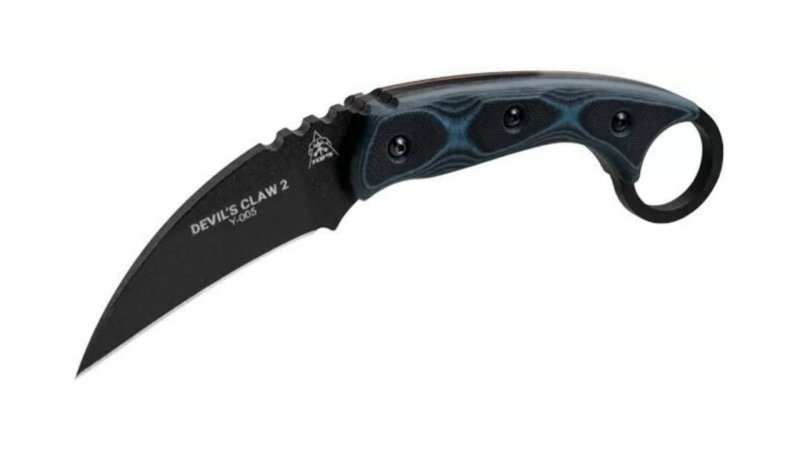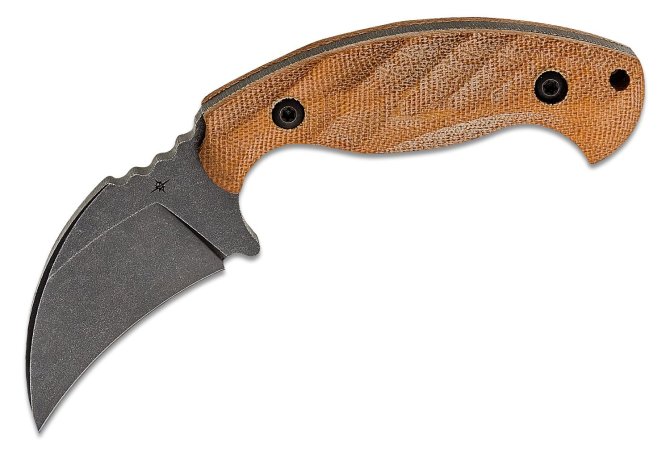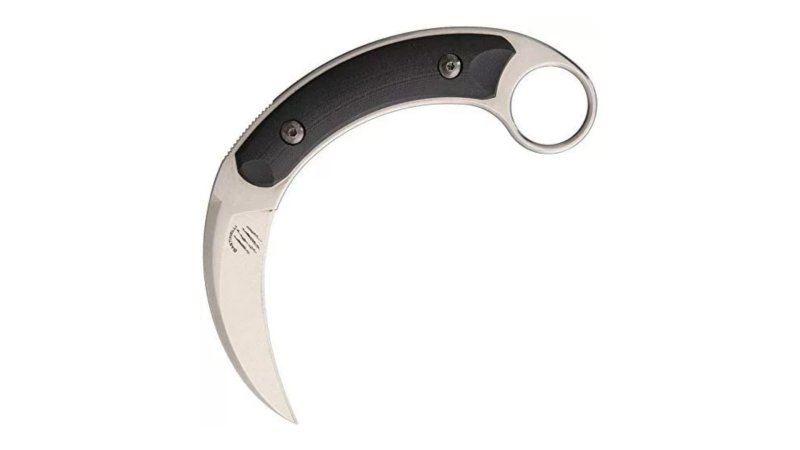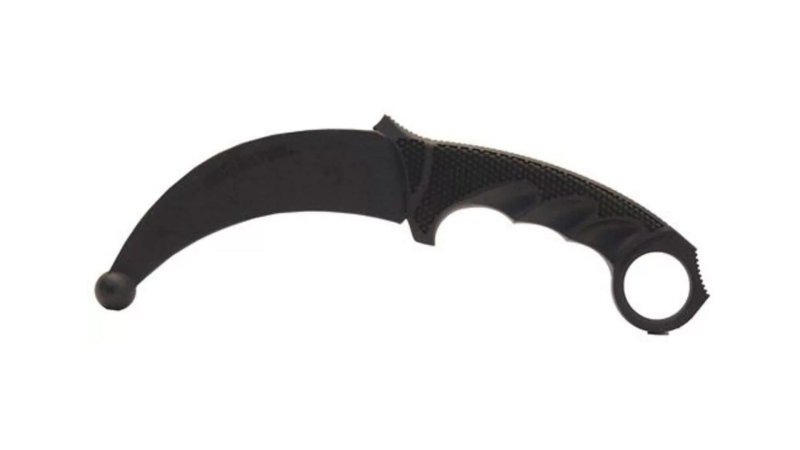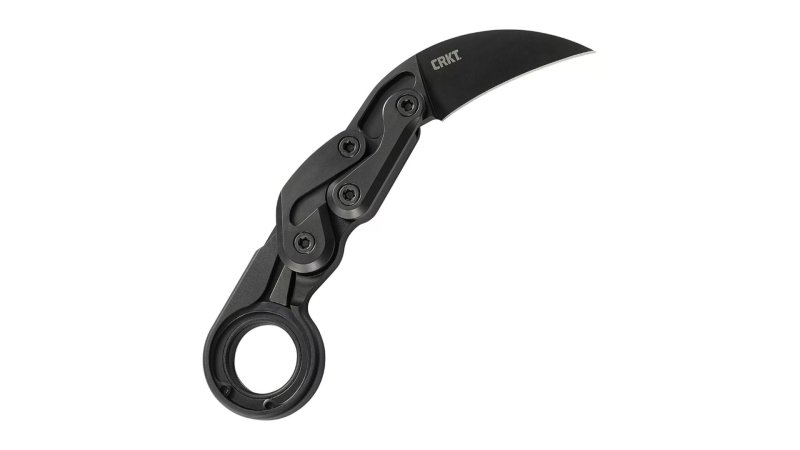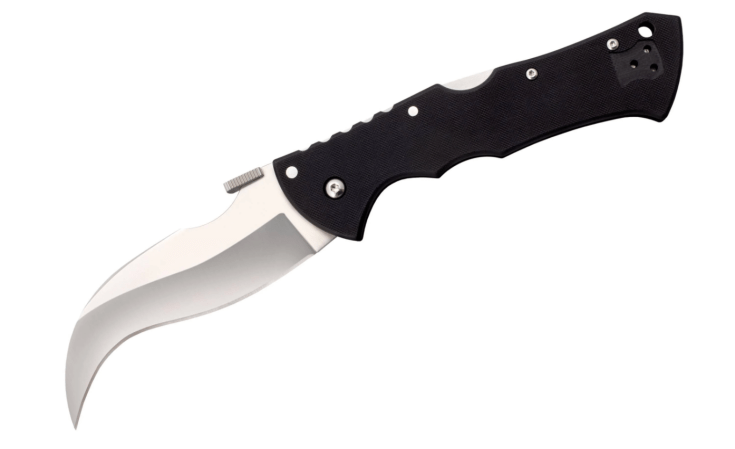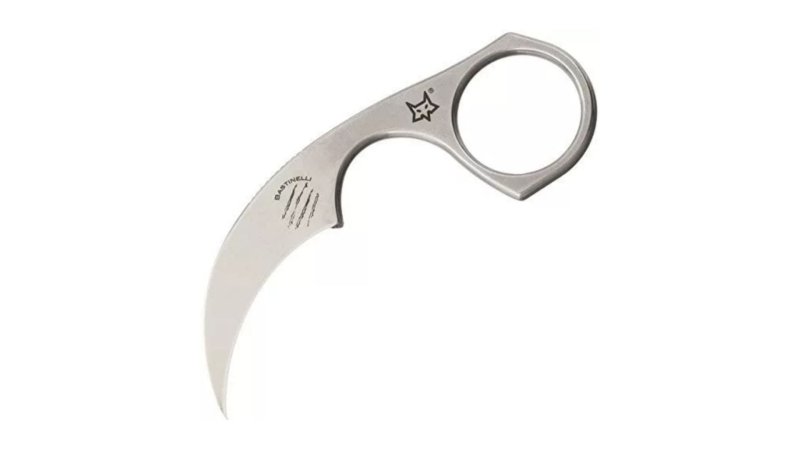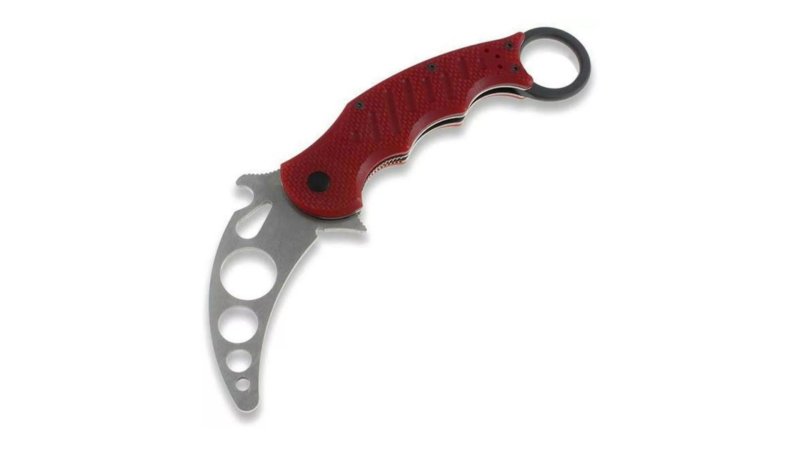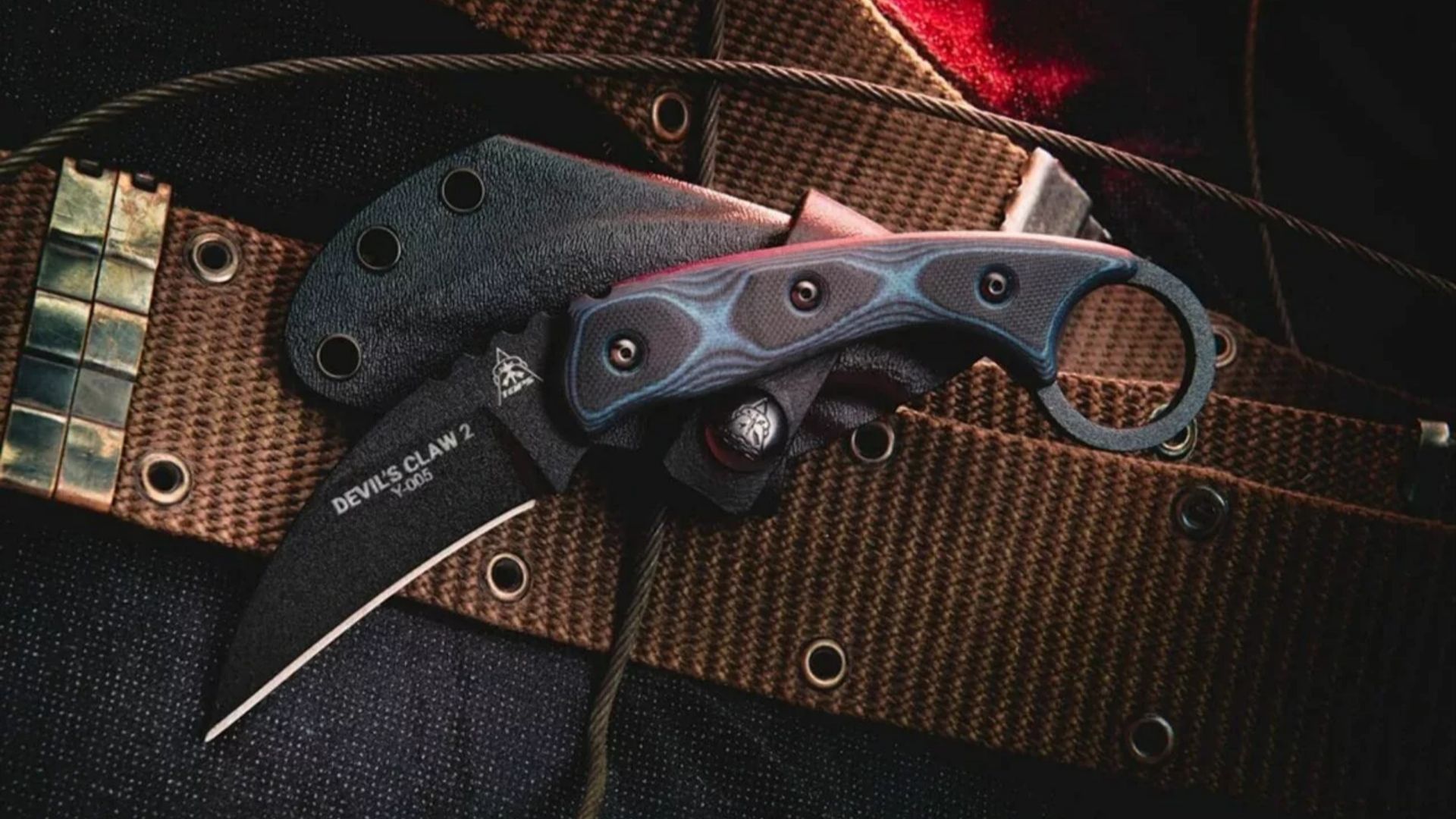

We may earn revenue from the products available on this page and participate in affiliate programs.
“Taken,” “Burn Notice,” and “Die Hard With a Vengeance” all have one blade in common: the karambit. Originating in 11th century Indonesia, it was purportedly designed to mimic a tiger’s claw, though it was most commonly used as a general-purpose utility knife originally. It was soon recognized for its martial value, however, and saw extensive combat use throughout Southeast Asia.
Karambits may vary in size, but they do share some common features: They have a hawkbill-shaped blade, typically with a very acute tip, and the majority have a finger ring on the pommel. The ring allows for a more secure and consistent draw and helps lock your grip in place, even in extreme environments. This makes it especially useful for those in wet environments, rock-climbers, and first responders as an EDC knife. The needle-like tip allows for pinpoint accuracy and easy penetration, while the recurved blade pulls the material in, utilizing the entire edge without the blade being able to slip out.
While it might be a staple of mall-ninjas everywhere, the karambit has undeniable functionality, both for utility and self-defense. It’s used in quite a few martial arts, including Silat, Kali, Arnis, Eskrima, Bersilat, and Kuntao. Read on for our list of the best karambit knives on the market.
Best Overall
Tops Devil's Claw 2
Pros
- Tough 1095 steel is easy to sharpen and has decent edge retention
- Full tang
- Kydex sheath
- Black Traction Coating for improved grip/corrosion resistance
- Made in USA
Cons
- 1095 steel is more rust-prone than stainless steels
Product Specs
- Blade length: 3.13 inches
- Blade material: 1095
- Blade finish: Black traction coating
- Handle material: G10
- Weight: 5.6 ounces
- Weight w/sheath: 7.2 ounces
- Sheath material: Kydex
Best Value
Schrade SCH111 Karambit
Pros
- 9Cr18MoV has good edge retention/corrosion resistance
- Full tang
- Rust- and wear-resistant TiN coating
- Lightweight
- Inexpensive
Cons
- Handle might be too small for some hands
- Cheap sheath
Product Specs
- Blade length: 3 inches
- Blade material: 9Cr18MoV
- Blade finish: Gray TiN
- Weight: 2.29 ounces
- Sheath material: Thermoplastic
Editor’s Choice
Toor Knives Karsumba
Pros
- Premium CPM S35VN steel for toughness/edge retention
- Full tang
- Kydex sheath
- Made in USA with lifetime warrant
Cons
- Price
Product Specs
- Blade length: 2.5 inches
- Blade material: CPM S35VN
- Blade finish: Black MicraCoat
- Handle material: Canvas micarta
- Weight: 6.5 ounces
- Sheath material: Kydex
Best Fixed-Blade Karambit
Bastinelli Kalinou
Pros
- N690 has good edge retention/corrosion resistance
- Full tang
- Lightweight
- Kydex sheath
Cons
- Price
Product Specs
- Blade length: 2.75 inches
- Blade material: Bohler N690
- Blade finish: Stonewash
- Handle material: G10
- Weight: 2.9 ounces
- Weight w/sheath: 3.8 ounces
- Sheath material: Kydex
Best Fixed-Blade Karambit Trainer
Cold Steel Karambit Trainer
Pros
- Inexpensive
- Santoprene is durable, yet flexible
- Ergonomic
Cons
- No sheath
Product Specs
- Blade length: 4 inches
- Material: Santoprene
- Weight: 2.4 ounces
Most Innovative Karambit
CRKT Provoke
Pros
- Semi-stainless D2 steel for good edge retention
- Rust- and wear-resistant TiN coating
- Compact design
- Aluminum handles
Cons
- Price
- More moving parts mean more potential points of failure
Product Specs
- Blade length: 2.41 inches
- Blade material: D2
- Blade finish: Black TiN
- Handle material: Aluminum
- Locking mechanism: Liner lock
- Weight: 6.1 ounces
- Sheath material(optional): Thermoplastic
Best Fighting Karambit
Cold Steel Black Talon II
Pros
- Premium S35VN steel
- TriAd lock
- Demko Thumbplate
- Scary sharp
Cons
- Not a traditional karambit profile
- Stiff pocket clip
Product Specs
- Blade length: 4 inches
- Blade material: CPM S35VN
- Blade finish: Satin
- Handle material: G10
- Locking mechanism: TriAd lock
- Weight: 4.8 ounces
- Pivot type: Phosphor-bronze and Teflon washers
Best Compact Karambit Fixed-Blade
Bastinelli Diagnostic
Pros
- N690 has good edge retention/corrosion resistance
- Full tang
- Durable cerakote coating
- Extremely small and lightweight
- Kydex sheath
Cons
- Two-finger handle
- Price
Product Specs
- Blade length: 1.75 inches
- Blade material: Bohler N690
- Blade finish: Black cerakote
- Weight: 0.93 ounces
- Sheath material: Kydex
Best Folding Karambit
Fox Knives 479 Karambit
Pros
- N690 has good edge retention/corrosion resistance
- Emerson wave feature
Cons
- Stiff pivot
- Rough-textured G10 handles
- QC varies
Product Specs
- Blade length: 3.1 inches
- Blade material: Bohler N690
- Blade finish: Black Idroglider
- Handle material: G10
- Locking mechanism: Liner lock
- Weight: 3.53 ounces
- Pivot type: Phosphor-bronze washers
Best Folding Karambit Trainer
Fox Knives Karambit Trainer
Pros
- Red handle and skeletonized blade for easy verification
- Blunt blade
- 420c steel for toughness and corrosion resistance
- Rough-textured G10 handles
Cons
- Stiff pivot
- Rough-textured G10 handles
- QC varies
Product Specs
- Blade length: 3.1 inches
- Blade material: 420C
- Blade finish: Satin
- Handle material: G10
- Locking mechanism: Liner lock
- Weight: 4.59 ounces
- Pivot type: Phosphor-bronze washers
Why you should trust us
A self-described knife nerd, I’ve dabbled in blacksmithing, martial arts, and competitive shooting in the past. My past reviews for Task & Purpose include the Cold Steel American Lawman, WE Stonefish, Leatherman Curl, Cold Steel Storm Cloud, and Spyderco Slip Stone.
Types of karambits
Karambits come in many different forms and sizes. No matter what task you have in mind or what your local restrictions are, it’s probable that you’ll be able to find a blade that suits your needs. Whether you’re a Kali practitioner or in need of an EDC/utility knife, there are options for you at pretty much every price point.
Fixed-blade
A fixed blade is any knife with a blade that is “fixed” in place, meaning that it doesn’t have a pivot and is firmly, immovably attached to the handle. They’re essentially the opposite of pocket knives. The blade is always exposed unless it’s sheathed. They’re simple, easier to manufacture than folding knives, and very user-friendly due to the absence of a confusing locking mechanism. Fixed-blades can be double- or single-edged.
Folder
Also referred to as a pocket knife, a folder is a compact knife that features one or more blades that fold up into the handle in lieu of using a bulky sheath. Meant to fit easily inside your pocket, these knives are legal to carry in most places, and are convenient to carry and use daily. They are frequently smaller than fixed blades, with blades typically between three and four inches long, although there are many exceptions that are both longer and shorter than this. Folding karambits are also limited to being single-edged, due to the spine of the blade always being exposed. However, they’re quite handy — they can do everything from peeling an apple to cutting rope or canvas to opening packages. Though these folding knives are typically smaller and not as strong as their fixed blade siblings, they’re highly versatile.
Trainer
These are commonly used for practice and training as a notably safer substitute for “live blades,” i.e., knives that are sharp. Typically, trainers are made of rubber or plastic, though unsharpened, blunted metal training blades do exist.
Key features of karambits
Blade length
Depending on the intended use, you might need a longer or shorter blade. For utility uses, you’ll want something around three to 3.5 inches; for self-defense, it will depend on how you train, in addition to taking into account the laws for your state, county, and city, in case they restrict your maximum blade length. Typically self-defense karambits are on the smaller side so that they’re easier to conceal, but there are exceptions.
Blade profile
While a karambit can be used for utility tasks, typically you’ll want one that is more of a traditional hawkbill shape, with a thicker, stronger tip. A lot of karambits are designed with a super-thin tip and extreme recurve, which is great for self-defense and martial use, but probably won’t work as well for utility
Steel type
There are a ton of different karambit models available in different steel alloys, depending on your use and environment. High-carbon steels tend to be tougher and easier to sharpen than stainless steels, but rust much easier, and often don’t have as good edge retention as premium stainless steels. Lower-end steels like those found on gas station knives are cheaper and typically easier to resharpen, but premium steels, whether stainless or carbon, tend to have noticeably better edge retention and toughness.
Benefits of karambits
Finger ring
Also referred to as a safety ring or retention ring, a finger ring is one of the most recognizable features on your average karambit. As its different names suggest, it’s a metal ring on the rear of the handle that you can slip your finger into. This helps you retain your grip on the knife, whether the blade got stuck, you’re using it in adverse conditions, or your assailant is trying to wrestle it from your grasp. When held in the traditionally-used reverse-grip, the ring can be used similarly to brass knuckles. However, it’s important that the ring is large enough, thick enough, and chamfered so that you don’t run the risk of degloving your finger.
Needle tip
When compared to other hawkbill blades, karambits tend to have significantly thinner, pointier, needle-like tips. This is especially true for those designed for self-defense and martial arts. It allows the blade to slip into softer materials with minimal resistance but is less durable against hard materials than other, thicker tips.
Recurved blade
One of the other most notable features of the karambit is the downward curve of the blade, or recurve. As a type of hawkbill, this recurve helps pull the material you’re cutting further into the blade, whereas upswept blade designs like the clip point and drop point might slip away or glance off.
Karambit pricing
Budget
Plenty of karambits are budget-friendly and priced at $100 or less. You’ll find quite a few fixed blades and a few decent folders in this price range. If you just need something as soon as possible for self-defense, an expendable tool, or if your inner Scrooge absolutely has to pinch those pennies, this might be for you.
Mid-range
If you’re looking for a karambit that offers the best bang for your buck, you’ll find most of those in the mid-tier range of $100 to $300. These knives will tend to be made with better materials, designs, and overall much better quality control.
Premium
Only accepting the best of the best? You’ll want to look in the $300-and-up price range. Here’s where you’ll find specialized karambits and custom knives, and they’ll typically come with premium materials and a great warranty.
How we chose our top picks
We chose our top picks by looking at karambit knives at various price points and then assessing which ones had the best customer reviews and highest ratings. We then examined the durability and versatility, along with the materials and quality control that went into making each knife. Karambits that had no-name stainless steel blades, poor ergonomics, or sheaths that weren’t ambidextrous were eliminated.
FAQs on karambit knives
You’ve got questions, Task & Purpose has answers.
Q: Is it illegal to carry a karambit?
A: Karambits are legal in most states, but it depends on your state’s knife laws and local restrictions. Laws that limit your blade length or ban carrying fixed-blades concealed can severely limit your options. To check out your state’s knife laws, click here.
Q: How dangerous are karambits?
A: As dangerous as any other knife. Without proper self-defense training though, karambits become less dangerous to assailants and more dangerous to the user.
Q: Is a karambit used for self-defense or utility purposes?
A: While the karambit is primarily designed for self-defense, it can still be used for many utility tasks. Some karambit models are designed primarily for self-defense, others for utility, and some as a happy medium between the two.
Q: I think karambits are cool, especially for doing tricks with. Should I get one?
A: No. Spinning a karambit around your finger might look cool, but it serves no practical use, and you risk accidentally cutting yourself. There are a lot of important nerves, tendons, and blood vessels in your hands and forearms that are at risk if you play with your karambit. Karambits are tools, not toys.
Q: Are karambits good for self-defense?
A: The short answer is no. The long answer is that successfully using a karambit for self-defense requires training, and a lot of it, so we’d heavily advise against getting one for self-defense unless you’re willing to put in the time and effort to become proficient.
Our gear section
Josiah Johnston is an active duty Marine stationed at Camp Pendleton, originally from the Eastern Panhandle of West Virginia. He’s dabbled in blacksmithing, martial arts, competitive shooting, and is a self-described knife nerd.
